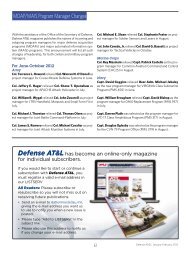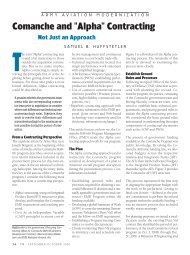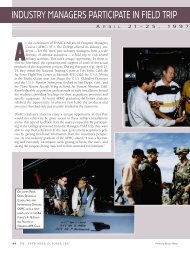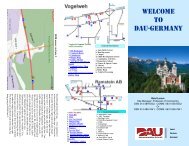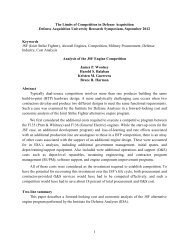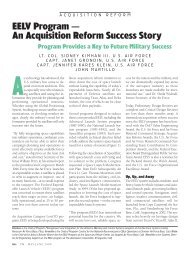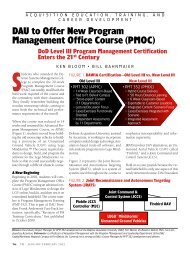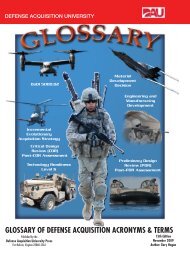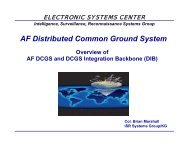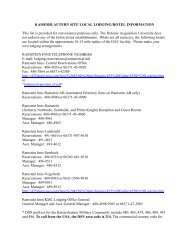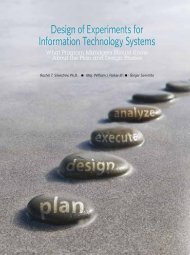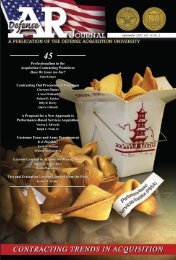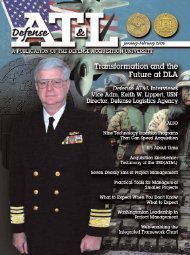Defense ARJ - Defense Acquisition University
Defense ARJ - Defense Acquisition University
Defense ARJ - Defense Acquisition University
Create successful ePaper yourself
Turn your PDF publications into a flip-book with our unique Google optimized e-Paper software.
Our policy to counter international terrorists rests on the following<br />
principles: (a) make no concessions to terrorists; (b) bring all pressure<br />
to bear on all state sponsors of terrorism; (c) fully exploit all<br />
available legal mechanisms to punish international terrorists; and (d)<br />
help other governments improve their capabilities to combat terrorism<br />
(Clinton, 1997, p. 14).<br />
PPBe: a reD or a Blue Pill?<br />
Conspicuously absent in this historic plan is the need to prosecute a global war<br />
on terror of the magnitude the United States is engaged in today. Finally, the now<br />
defunct Joint Vision 2020, published in June 2000, focused on a force protection,<br />
antiterrorism goal without mention of a major DoD comprehensive role in combating<br />
terrorism in an offensive way. One could conclude that these strategy documents<br />
hardly guided creation and acquisition of DoD capabilities to counter terrorism; and,<br />
with the advantage of hindsight, they were insufficiently visionary to mobilize the<br />
military toward a global war on terror that emerged within the future year defense<br />
planning window. Also important to note is that none of these documents made<br />
mention of foreseeable military operations that would include the need for military<br />
support for stability, security, transition, and reconstruction operations. The issue is<br />
not the quality of the planning process; rather, it is the belief that the strategy-making<br />
process can predict the future with any reasonable certainty. The entire PPBE process<br />
is based upon that belief. Unfortunately, environment is not cooperating with these<br />
linear expressions of causality.<br />
sHareD MinDfulness of tHe conteMPorary<br />
oPeratinG enVironMent<br />
The COE is best described as hyperturbulent and characterized by the velocity<br />
and degree to which patterns of otherwise quasi-stable environmental changes are<br />
shifted to unstable, maladaptive patterns (McCann & Selsky, 1997). One convincing<br />
paradigm that acknowledges the complexity of sensemaking in the midst of the<br />
disorder and chaos associated with hyperturbulence is Rittel’s and Webber’s (1973)<br />
theory of wicked problems (similarly described as “messes” by Ackoff (1999, p.<br />
178). According to these observers, “Social problems are never solved … at best they<br />
are only re-solved—over and over again” (1973, p. 160). I paraphrase and interpret<br />
Rittel’s and Webber’s distinguishing properties of wicked problems as follows:<br />
� No definitive formulation. This includes the recognition that complex problems<br />
are ill-defined and/or that more information does not make the problem<br />
less ambiguous.<br />
�<br />
No stopping rule. That is, past solutions or best practices may continue even<br />
if conditions change, and the conditions of the problem change more rapidly<br />
than a planned, programmed, or budgeted change can keep up with; hence,<br />
the solution becomes disconnected from the problem as the problem morphs.<br />
Finally, turnover and fluidity of participants in the affected organizations or<br />
institutions further confound the process.<br />
1 5 7



